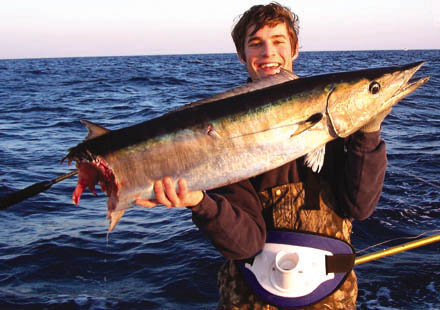
The Saltwater Magazine for Gulf Coast Fishing!
FISHING FORECASTS
| FISHING CALENDARS | ARTICLES | ADVERTISE
| SUBSCRIBE
Search Gulf Coast Fisherman's
Web Site
Past articles, specific
places or fish, etc.

WAHOO!
by Chester Moore
| CURRENT
MOON lunar phases |
World-class wahoo await anglers in cold Gulf waters.
- "Wahoo!"
- For a second I did not know if my buddy Chris was shouting his approval at fighting the big dolphin on his line or if indeed one of the fast-moving toothy creatures with the funny name had moved in on the weed line we were fishing.
- Just as I reached the back of the boat to take a look, my rod doubled over and a silver flash exploded out of the water with a big, chrome Rapala in its mouth. I do not know how many of you have ever had two anglers battling a bull dolphin and a 50-pound wahoo in the back of a 26-foot boat, but you should not be surprised when I say it was a miracle we landed the fish. They zigzagged all over the place and only by the Grace of God, they did not tangle up...

- Wahoo fishing is about as exciting
as anything on the Gulf Coast and during the winter months, anglers in
Texas and Louisiana have a good chance at catching these beautiful, hard-fighting
fish.
- The problem with wahoo is very little has been written about the life habits and physiology of the species and I think that is one reason there is still an air of mystery about them to many anglers.
- It is time to make that a thing of the past.
- Florida Atlantic University has an entire wing of their scientific department dedicated to studying wahoo and has a greater understanding of the species than any other institution. This knowledge can greatly help anglers better understand their quarry.
- "Wahoo, (Acanthocybium solandri), are a pelagic or epipelagic marine fish that inhabits tropical and subtropical waters worldwide. Wahoo may also be found in temperate regions during the summer when surface water temperatures reach approximately 68 degrees. Wahoo are frequently encountered far offshore, often as far as mid-ocean regions. Wahoo can also be found in the deeper water just outside sharply sloping coral reefs, offshore banks, and 'humps'. Like many predator species, they are attracted to current edges and temperature breaks, especially when these occur in or very near drop-offs or deep water," they said.
- "Larger wahoo (i.e. over 40 lbs) are generally solitary, but may occasionally be found in groups of two or three. Smaller wahoo are sometimes encountered in small- to medium-sized loose schools; in some areas wahoo of all sizes appear to aggregate during specific times of the year."
- Capt. Scott Avanzino of Paradise Outfitters ((985-845-8006) has written extensively about wahoo and recommends that to catch these mysterious fish anglers keep the details of their habits in mind and fish their baits on the fast side, and try a mixture of them.
- "I like to troll three to five different baits anywhere from eight to ten knots. I like hard baits, soft surface baits and natural baits. Braid Marauders and Yo-Zuri Bonitas are by far the best plugs. They hold up, troll fast and are easy to reel in. They work best when fished close to the boat in purple, black or tiger colors. I like to set the first one about 10 to 20 yards back followed by a second bait 10 yards behind the first one," he writes.
- "Then I will follow with a pink-skirted ballyhoo and a blue and white Islander or Black Hole with ballyhoo on the riggers. I may also try running a rigged ballyhoo on a downrigger in green water set at the depth where bait show up on the sounder. Only problem with the downrigger is it limits you to a top speed of five to eight knots but some days it's the only bait a wahoo will hit so it is a definite must to have one."
- He also noted if you are going to move from location to location it is never a bad idea to troll in open water. You are going to cover the ground anyway.
- "Might as well do it in comfort with a shot at a fish, and on rough days it makes perfect sense. At eight knots, you can cover nearly 50 miles in a half day. Last fall when no other conditions were found we decided to work the 100-fathom curve in open water and it resulted in a 93-pounder early on. No telling how the rest of the day would have been since rough seas and an unsettled crew made for an early day."
- Conversely, Avanzino notes if you encounter calm conditions in clean water; try high-speed trolling two baits at 15 to 18 knots when moving from place to place.
- While conducting research for this article I came across a web posting by veteran wahoo angler Tom Barman who recommended using strips of bonita to lure in big wahoo while trolling.
- "Bonita Strips!"
- "They are very important, use mullet if they are not available. The first thing you need is a wire line rod and reel. The Penn 6/0 high speed works well and for the rod a bent butt with a wire line guide is the way to go. If you are on a budget, you can get a stand up rod with the wire line guide for less. Once you use wire line you will be hooked."
- "I always use a planer board I like the #3, if I am running a second wire line I will use a 2 pound cigar weight. The reason is that you will not tangle. If you use the same you will tangle."
- From the planer or weight, he runs a second mono line at 100-pound test with no wire.
- "Live on the edge. You will get a lot more action with out wire, you will get cut now and then," he said. "I like to use sea witches in pink or blue and white. Rig them with the bonita strips. Wahoo like to hang in 200 to 300 feet. Troll in one direction if you get a hit turn back around but swing way out and reset your lines in the direction of your last hit. They feed with or against the current; it is one way or the other. they bite in the morning and afternoon."
- Capt. Ryan Warhola (409-718-8623) caught lots of big wahoo (including a 97-pounder) out of Galveston last year by using similar trolling techniques.
- "Last year out of the Flower Gardens off Galveston we caught some world class wahoo," Warhola said. "I don't think anyone who has ever tangled with a 'hoo' that big really has an idea of what kind of fight you're talking about. Imagine a kingfish double-sized and on steroids and all kinds of stimulants and they you have these huge wahoo."
- He recommends anglers take advantage of structure rising out of deep water in the Gulf.
- "Wahoo love structure just like any other fish. Out around the Flower Gardens you have this huge structure coming up out of the Gulf and then out in a close enough vicinity to run on the same trip you have Stetson Rocks and other big structure to focus on. They will certainly run in open water, but by fishing the structure that's way out there you can focus your efforts on particular areas of high probability and you will want that on such a long trip, especially if you have not done it before," he said.
- Warhola recommends anglers troll around as much as possible because covering water is the key.
- "If you're after really big wahoo they are not usually going to be schooling and making a fuss. You have to cover what to find those fish and its really a game of patience. If you can put your efforts on some key areas and be patient, you can catch really big hoo out there. Just remember you can't catch fish if your line is not in the water."
- My experience with big wahoo has always been having a couple of big fish hit during the course of a day and wear you out so bad you think you fought 100 of them. They always seem to move in like lone wolves, prowling the depths for pray and occasionally thrilling anglers with their determined, dynamic, fast-paced fighting.
- Wahoo indeed!
- Wahoo growth rates amazing
- Florida Atlantic University's research has uncovered much about the intriguing aspects the growth rates of wahoo.
- "Wahoo growth rates have not been conclusively determined however there is some evidence indicating that wahoo may grow quite rapidly. Only a couple of fish have been tagged and recovered such that their weight change over time could be calculated. One of these fish grew about 22 lbs in just 10 months, from 11 lbs to 33 lbs. Like many other questions concerning wahoo, more research is needed to determine how typical this one growth rate really is," they said.
- "Growth rates can vary depending on age, sex, and region. Because of this, sample sizes need to be large and need to include individuals from many regions, of both sexes, and of varying sizes."

